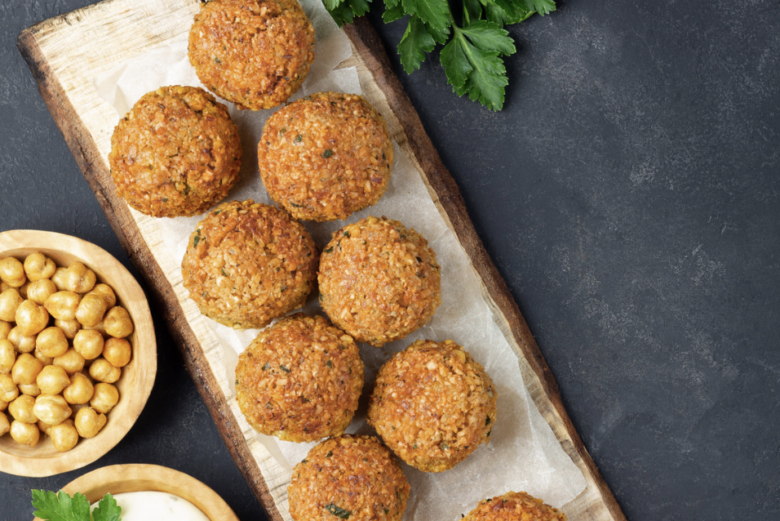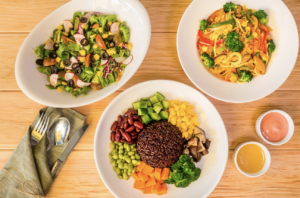The Best Authentic Falafel Ever—My Family’s Secret Recipe—Using Fresh Herbs, the Right Spices, and Chickpeas! Plus, I’m going to show you how to make falafel the right way, whether you choose to bake it or fried it. If you want to know how I create it, you need watch the video as well.
How do you like to eat falafel? Warm pita sandwiches topped with hummus or tahini sauce and my easy Mediterranean salad of cucumbers and tomatoes are my favorite way to eat them. However, it goes well with a variety of different dishes or as a mezze platter (there are plenty of suggestions for both below!).
A buddy of my father’s had a little falafel stand right in the middle of the souq. On many weekends, we would make the journey to Mr. Bishay’s house to enjoy his aromatic falafels. Their aroma may be detected from great distances!
I am thrilled to finally get around to sharing the recipe for the real falafel that I have perfected over the years. It tastes just like what you’d get on Middle Eastern streets—authentic and excellent. And it’s simpler to whip together than you would imagine!
Falafel, what is it?
Popular “fast food” in the Middle East, falafel is a ball or patties prepared from a combination of chickpeas (or fava beans), fresh herbs, and spices. Falafel likely originated in Egypt, when Coptic Christians sought a substantial meat substitute during the lengthy Lenten fast. Even in Egypt and other Middle Eastern countries, it has gained popularity as a vegan dish.
You can find street sellers selling falafel in almost every area in Egypt, and it continues to be the daily chow for the people. The traditional sandwich toppings include roasted or fried eggplant slices, a plethora of Mediterranean salad, and a dollop of tahini.
Incredibly easy to make using common, basic ingredients, this vegan cuisine will blow your mind. Invest in premium spices, such as cumin and coriander, for your falafel recipe, since these are essential components to delicious falafel. Below this, I have a few additional suggestions for you…
My favorite part about this dish is that it calls for fresh chickpeas instead of canned ones. Dry chickpeas are the way to go if you want the most texture and taste. The falafel patties will fall apart in the heated oil because the chickpeas used in many falafel recipes are not real.
Filling and tasty. You won’t feel hungry after eating just one falafel patty because of all the plant-based nutrients and chickpea protein they contain. In addition to fresh herbs, my recipe calls for the ideal combination of spices (cumin, coriander, and a pinch of cayenne) to bring out their robust, real taste.
You can make this ahead of time and store it in the freezer without ruining it. I really like that you can make the falafel patties in advance and store them in the freezer until you’re ready to eat them.
Do not use canned chickpeas; instead, use dried chickpeas. An essential component that will impart the correct texture and flavor to your falafel are dried chickpeas that have been immersed in water for six hours. As a helpful hint, I often soften the dried chickpeas by adding around ½ teaspoon of baking soda to the soaking water.
An essential component of this traditional dish is the use of fresh herbs, such as parsley, cilantro, and dill.
– Onion: I usually go for yellow onions, but you may use white or red ones too.
– Garlic: use fresh garlic cloves for the greatest taste.
Pepper and kosher salt: season to taste.
Cumin, coriander, and a pinch of cayenne pepper are the spices. This combination of spices, in addition to the fresh herbs, is responsible for the robust, original flavor of falafel.
– Baking powder: falafel gets its light, fluffy texture from this ingredient; many recipes omit it, thus the falafel turns out overly thick.
You may skip this step if you don’t like the nuttiness, but I recommend using sesame seeds.
Falafel Recipe: Step-by-Step 1. Let chickpeas soak for at least a day. Soak them in a large basin of water with a pinch of baking soda added to help them soften. Soaking the chickpeas will cause them to swell by a factor of two. Thoroughly drain.
Soaked chickpeas for 24 hours
Prepare the mixture. To a food processor, add chickpeas, fresh herbs (dill, parsley, and cilantro), garlic, onion, and spices. Pulse the mixture until it reaches a fine powder. When it reaches a consistency more like to coarse grain, you will know it is done.
& Keep in the fridge (critical). Place in the fridge for a minimum of one hour, or even overnight, after transferring the falafel mixture to a bowl and covering it. The falafel patties will be simpler to shape after chilling since the mixture will be more cohesive.
Preparing falafel in a food processor
3. Shape into balls or patties. After the falafel mixture has cooled down, add the baking powder and toasted sesame seeds. Roll into balls or patties about the size of a golf ball; if making patties, don’t flatten them too much so they cook up fluffy.
Falafel patties, size 4. Fry. The finest and most conventional way to cook falafel is in a skillet, although there are other methods as well. The oil should be heated to a temperature of around 375 degrees Fahrenheit, but not so hot that the falafel crumbles, so cook it on medium-high heat until it gently bubbles.
Fry the falafel for three to five minutes, or until it becomes a medium brown color, using a slotted spoon to carefully put it into the oil. If you must cook the falafel in batches, do not crowd the pan.
A helpful hint: cook one falafel at a time to see whether the oil temperature needs adjusting.
Fried falafel, only one
Falafel is a versatile dish that works well for every meal of the day. Like many Americans, most Middle Easterners eat falafel first thing in the morning, and that includes most Egyptians.
Crucial Hints
In case you didn’t see them before, I included a few of them in the post:
1. Don’t ever use wet chickpeas. For the greatest texture and taste, use dry chickpeas that have been soaked in water for at least 24 hours. You can keep your falafels from falling flat by using dry chickpeas, which are inherently starchy. Using chickpeas straight from the can may cause your falafel to fall apart in the hot oil.
Refrigerate the falafel ingredients. For easier shaping, let it chill for at least an hour. The falafel mixture can be made the night before and chilled, so that’s excellent news.
3. Before shaping the falafel mixture into balls or patties, add the baking powder. Here, baking powder acts as a rising agent, resulting in falafel that is rather airy.
Do not overcrowd the pot while you fry in oil that is boiling. Unfortunately, deep-frying is your only bet for wonderfully crispy falafel. The ideal temperature for the cooking oil is moderate heat, just hot enough to bubble, but not so hot that the falafel fall apart. Use a deep fry-safe thermometer (affiliate link) if necessary; it should read around 375 degrees F (medium-high heat on my range).
5-Falafel, when done, should have an outside that is crispy and medium brown and an inside that is fluffy and somewhat green.
Instead of frying falafel,
Get the oven up to 350 degrees Fahrenheit and grease a baking pan. Toss the falafel patties with a little extra virgin olive oil before baking. Cook for 15 to 20 minutes, flipping once, or until golden brown.
Prep in advance and store in the freezer
Get a head start: The falafel mixture, once prepared, may be refrigerated for up to two days in advance. When you’re ready to cook it, shape it into patties.
Freeze uncooked falafel patties for 1 hour on a parchment-lined baking sheet. After the patties have solidified, place them in a freezer bag and keep them frozen for up to a month. Frying or baking falafel from frozen is a viable cooking option.
Middle Eastern Style Falafel Serving Options: In the Middle East, falafel is usually served hot with a heaping dollop of tahini sauce.
For the perfect falafel sandwich, toast some pita pockets, stuff them with falafel, top with tahini, and garnish with arugula, cucumbers, chopped tomatoes, and pickles.
Arrange your flalafel on a brunch board with a variety of fresh vegetables, cheese, and dips, much as I’m doing here.
As an accompaniment, pair falafel with tiny dishes of fried eggplant with a Turkish twist, tabouli salad, or Balela salad.
Dip it: My Classic Creamy Hummus and Baba Ganoush are two of my favorite falafel toppings.



